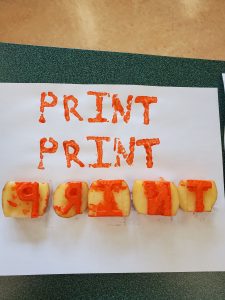

I am transported into the past as I pick up the knife to carve out my already drawn stencils. I picture the care and the skill it must have taken to carve these letters out of wood or create metal casts.
Was there something particularly challenging in the process?
This profession was essential, and I was surprised at how challenging it was. I realize that a clunky kitchen knife was not the best tool to create smooth curved letters, but I tried my best. I started to block out the letters in a grid on the potato. I looked to create long cuts across the entire length. Dragging the point of the blade left rough and uneven edges. Mostly, I struggled with the inside of the letters. I realized with a larger loop inside, the easier and more precise the letters became.
How much time did it take for you to create the stamps?
I would say the carving process took about 45 minutes. I took my time with the carving, and even though I watched the how-to video and watched Upside Down and Backwards, twice. I still carved the N as though I was reading it instead of backwards to stamp it. That took the longest time because I just couldn’t visualize it. I needed to write it down backwards and copy. I considered the stamping process and how each potato should be cut at the bottom of the letter to provide a flat surface to line up the letters.
Have you noticed anything particular about the letters that you have chosen to reproduce?
The letterpress tray is essential, and perhaps I should build one for my next attempt. I realized by stamping one letter at a time, the paint thickness was inconsistent, and after a few tries, the stamp slipped from my hand and landed over another letter’s imprint. I started to problem solve the errors, and I continued to practice after I made the two lines. Unfortunately, with all of my corrections, the soft texture of the potato started to break down. I was heartbroken that I had to stop. I knew that if I carved another letter, it would not look the same as the original. I love the stamp’s texture. The letters itself looked more like art to me. The only time I see writing this way is on event invitations anymore. I realize the value in this form of writing. I can see why capital letters are more prevalent in stencils. It was fun to create sharp lines and for them to be a good representation of the alphabet. Once I figured out the “N” the correct way, the I, N and T was the most pleasurable to carve. However, the “P” and the “R” produced more exciting results.
Considering the time and effort that took you to create a 5-letter word, how do you feel about the mechanization of writing?
After I have typed these 300 words on this page, I notice that I don’t see the digital letters, I am visualizing the story. It is my imagination and interpretation that is interesting. I look over at my imprints, and I see emotion, passion and history. Digital text in my life is informative, factual. The process of creating the letters and producing the word invited me to become invested in the overall process.
Hi Kristin,
Your “PRINT” looks lovely! The colours remind me of ketchup and potatoes, so part of me is curious as to how the print would turn out if you pushed your stamps into a sea of ketchup. From what I’ve seen so far, everyone who has done the potato printing has it so that the letters are printed.
I love your reflection on the focus shifts with the mechanization of text.
Thanks, Linda. And you know what?! My original word was going to be “FRIES”. Ha!
It is hard to describe my excitement for the task in such a short amount of words. From the outside, people might think it was a childish task, but I found in so reflective and analytical. I am curious to check out your task. Thanks for stopping in!
HI KRistin,
I like that you have recognized the investment in a creative print as emotional investment and passion. This is the biggest step on the road to engaging students and getting them to buy in to learning. While it may seem a little “grade school” to go all arts and crafts, it is these things that stand out in my memory as memorable learning experiences where I have felt most invested. I just wish I could come up with a way to stretch and compress a parabola on a potatoe.
Ha! I love the math reference. We will be forever linked in the Math Lab 🙂 I hope that my excitement for the project was clear enough. I really appreciated how reflective and analytical this fun project was. I was surprised by how much I got out of a relatively simple task.